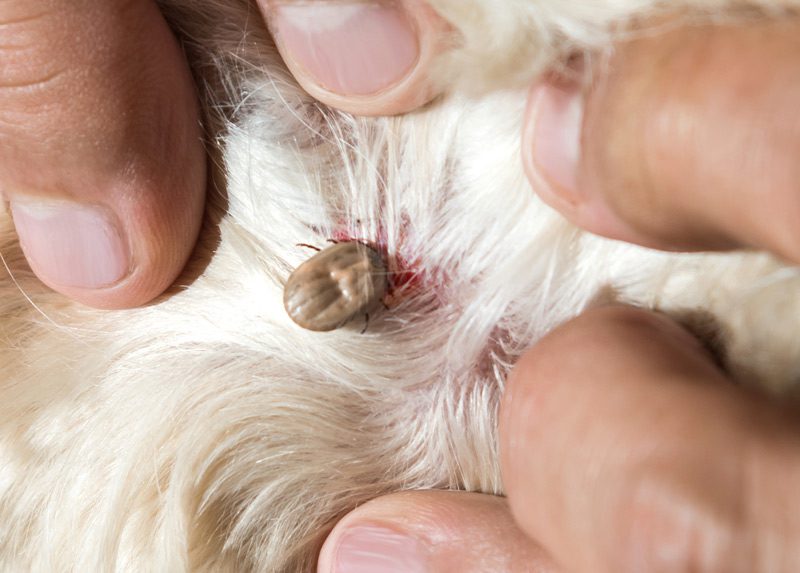
All about subcutaneous ticks in dogs: treatment and prevention
Demodicosis, common in dogs, is caused by a parasite, namely the subcutaneous mite Demodex canis. As a result of the development of the disease, the skin of the animal is significantly damaged, due to which the condition of the pet worsens. For this reason, it is important to make a diagnosis and start treatment in a timely manner.
Contents
General information about ticks
All types of ticks are carnivorous parasites. They can feed on skin, blood and lymph. Accordingly, you should not ignore the presence of such a parasite and delay the treatment of the animal. Time is of the essence, because ticks multiply very actively. Moreover, they carry various infections and create favorable conditions for the development of pathogenic microflora. Some parasites pose a great danger not only to dogs, but also to humans.
A pet that is regularly looked after and walked only in the yard is not protected from ticks. Such parasites can be found in a variety of places, including the owner’s clothes and shoes, the porch, and bedding recently purchased from the store. Naturally, compliance with the rules of hygiene reduces the risk, but it is best to use special drops or a collar as a preventive measure.
Symptoms and forms
With the development of demodicosis caused by a subcutaneous tick, the dog has a serious skin lesion. The most common symptoms include:
- redness of the skin, on which pustules, wounds and cracks form over time;
- the dog itches all the time;
- the animal begins to lose hair, and baldness is most noticeable in the head and paws;
- the affected areas smell unpleasant;
- often there is a violation of thermoregulation, due to which the dog may freeze in the heat.
Subcutaneous mites secrete waste products that cause discomfort to the pet. This can be itching and soreness, from which the dog often becomes irritable and avoids contact with the owners.
Forms of the disease:
- scaly. It is characterized by hair loss and the formation of red spots. Over time, these skin members dry out. This is where scales form. A sick dog tries to tear off dry crusts, combing itself until it bleeds. In addition to peeling, the development of a bacterial infection is often observed, due to which the inflammation intensifies.
- Pustular. Differs in the appearance of seals with a diameter of 4-5 mm. From such formations, pus is released, which has a pronounced unpleasant odor. Over time, brownish crusts can be seen on the affected areas. The animal becomes nervous and scratches the skin, as a result of which the infection enters the bloodstream. This often leads to death.
- Generalized. This form is a combination of the two above-mentioned varieties of the disease. The main feature is the lack of appetite. Moreover, the subcutaneous tick infects the internal organs, due to which the dog’s body is depleted.
Disease flow
To the development of demodicosis in dogs give the following factors:
- hormonal disorders;
- weakening of immunity;
- decrease in skin tone;
- hair loss.
In all these situations, the tick gets under the skin of the animal. The local environment is suitable for the active reproduction of parasites. Most often, ticks gather in places with many folds. These can be the areas around the eyes and lips, as well as paws.
In most cases, from a subcutaneous tick short haired dogs suffer purebred breeds. We are talking about boxers, pugs and French bulldogs.
As a rule, the development of demodicosis occurs at the age of 0,5-2 years. Moreover, the source of infection is sick animals, with which there must be close contact, and the parasite itself must go through all stages of maturation. In some cases, subcutaneous mites get to the puppy from the mother during childbirth.
It is known that unbalanced nutrition, surgical intervention and infectious diseases contribute to the development of the disease. Additional causative factors may include stress and antibiotic use.
Dog owners should be aware that they cannot get infected from an animal, since another type of subcutaneous mites poses a danger to people.
Diagnostics
To detect parasites, you need to regularly examine your pet. Particular attention should be paid to the paws and head, where there should be no suspicious seals. It must be remembered that in the first place in a dog, subcutaneous mites affect the areas between the fingers.
When observing alarming symptoms, it is urgent to visit a veterinary clinic. Experienced doctors will do a scraping, which will help make a diagnosis.
Treatment
Treatment of dogs from subcutaneous ticks is carried out only under the supervision of a veterinarian. First of all, the specialist is obliged to neutralize the parasite, as well as eliminate all conditions that contribute to the development of demodicosis. For these purposes, immunity is strengthened and hormonal levels are restored.
In most cases, complex treatment is prescribed. So, antiparasitic solutions are injected under the skin of the dog, and the integument is treated with special preparations. Most often, ivomec is used, which contains ivermectin, which kills parasites. The drug is prescribed in many clinics, so sometimes subcutaneous ticks have already developed immunity.
Outdoor treatment skin is of particular importance. Thanks to this treatment, it is possible to destroy the mites migrating on the skin of the animal. Experts recommend the use of immunoparasitan, which is often prescribed as a prophylaxis for demodicosis. Trypan blue can also be given intravenously.
List of the most commonly prescribed drugs:
- Acaricides including ivermectin, amitrazine and ivomec. Such medicines are needed in the fight against a subcutaneous tick, which has settled in the hair follicles and sebaceous glands of the animal.
- Immunomodulators, namely cycloferon, anandine and ribotan. These drugs help to alleviate the condition of the animal and strengthen the immune system.
- Vitamin complex.
- Preparations for the protection of the liver.
- Aversectin ointment and other similar creams for treating affected skin areas.
Previously, veterinarians prescribed chlorophos orally, but today this drug is not used due to toxicity. It is used only for processing the skin of an animal.
Elimination of pathogenesis
To strengthen the dog’s immunity and remove all the factors that lead to the development of the disease, it is necessary to engage in elimination of skin atony. Thanks to such measures, it is possible to strengthen the hair follicles. Accordingly, the parasite will not be able to get under the skin. For this purpose, it is necessary to add sulfur to the food of animals, and also to rub special preparations into areas where baldness is observed. When skin immunity is weakened, 2-3 drops of iodine solution are added to food.
To soften the skin of a dog, it is necessary to apply sea buckthorn oil or vitamin A solution to the affected areas. The substances contained in these products restore the skin. It is also important to brush the animal regularly to remove dead scales.
To improve the effectiveness of treatment, it is necessary to review the dog’s diet. Instead of fatty meats, preference should be given to turkey or chicken. If the animal is given ready-made feed, the dosage should be reduced. Due to this, the load on the liver will decrease, which contributes to a faster recovery.
In the absence of proper treatment possible serious consequences. So, in dogs with a generalized form of the disease, a subcutaneous tick damages internal organs, including the heart, spleen and stomach.
Folk treatment
If parasites are found in an animal, use folk remedies:
- Wormwood decoction with the addition of honey should be given to the dog in 100 ml every 2 hours.
- At home, you can independently make an ointment based on the root of celandine. The grass is poured with a small amount of sunflower oil and simmered at a temperature of about 40º C for 2-3 hours. Then the liquid is filtered and a small amount of sour cream is added. The finished ointment is gently rubbed into the damaged areas of the skin of the animal.
It must be understood that such folk remedies are gentle, so they are not always able to destroy the subcutaneous tick. Accordingly, it is necessary to additionally use the drugs prescribed by the veterinarian.
Prevention
Many owners do not know what to do when they find subcutaneous mites in a dog. At such a moment, you can’t hesitate, because only timely treatment will help to avoid damage to internal organs. Experienced dog breeders recommended for preventionso as not to risk the health of your beloved pet.
- The main preventive measure is to limit contact with sick animals. So, the pet should avoid stray dogs.
- During the walk, you should not visit abandoned premises.
- The animal must be regularly washed and combed.
- It must be remembered that the use of various medications without medical supervision often leads to the development of demodicosis. In particular, this applies to corticosteroid hormones, due to which the immune system is weakened. As a result, active reproduction of the subcutaneous tick begins.
- Since infection often occurs during childbirth, it is necessary to examine dogs for the presence of a tick before mating. It is also recommended to raise puppies from different bitches separately for 2-3 months.
The subcutaneous tick belongs to those parasites, the presence of which represents life threatening dog. To avoid possible complications, it is necessary to visit the veterinarian regularly and carefully monitor the condition of the pet. It is also important to take simple preventive measures.





